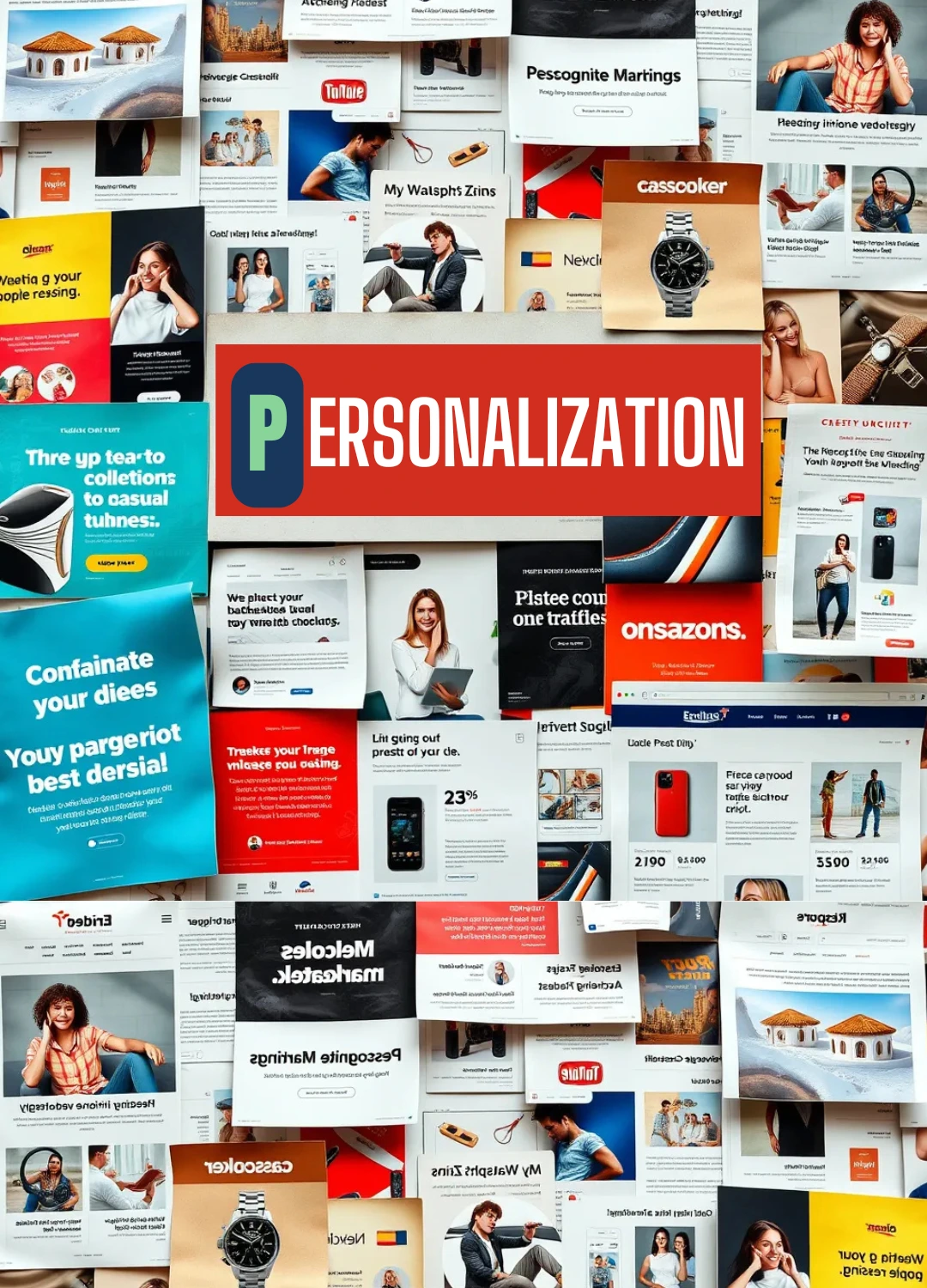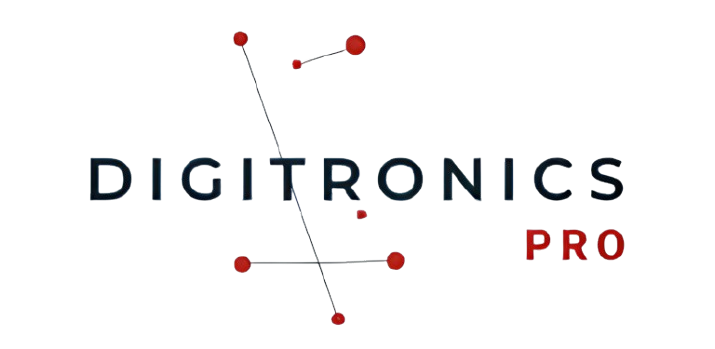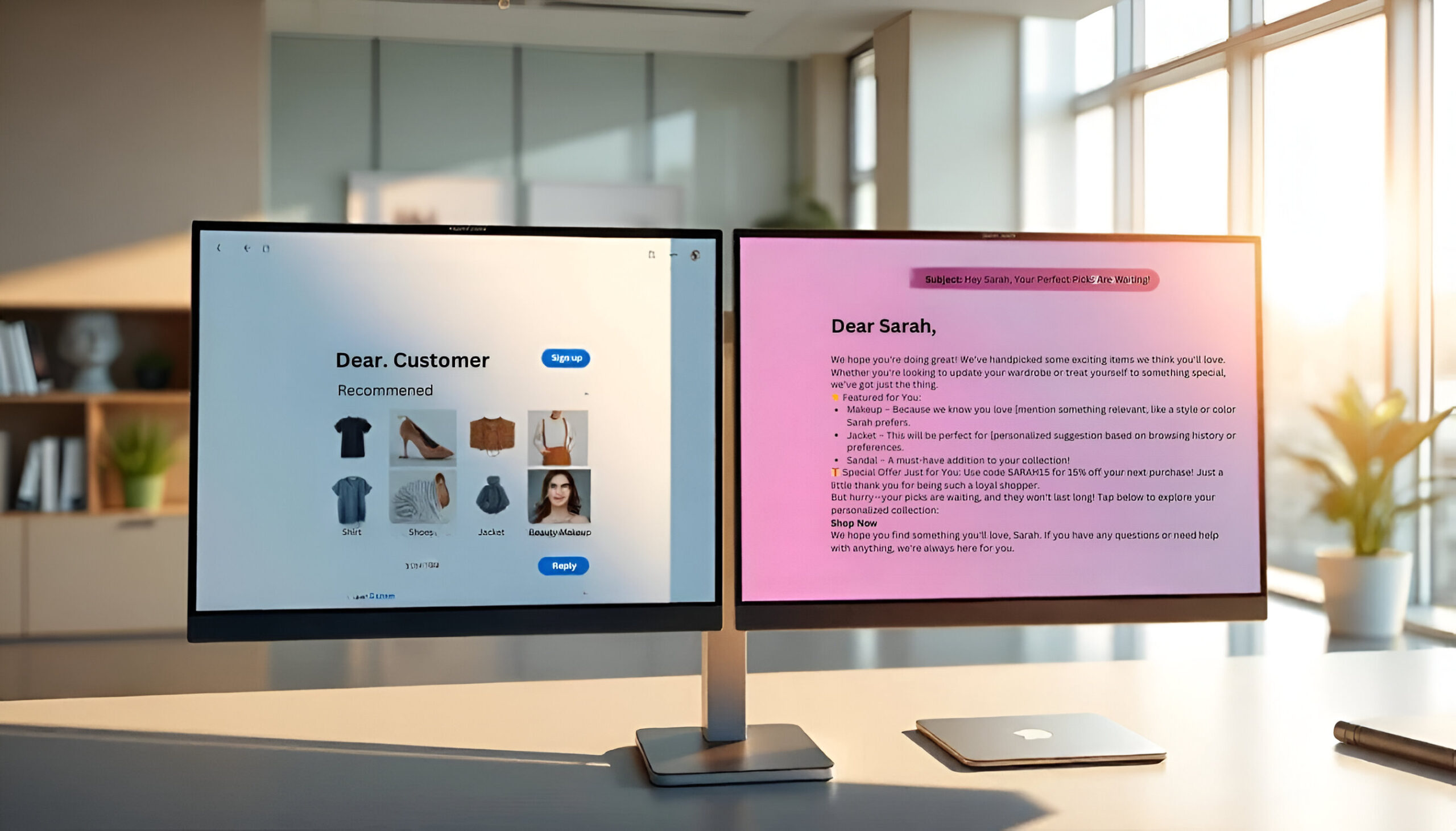Imagine walking into your favorite bookstore. The cashier smiles and hands you a book by your favorite author – before you even ask. It feels like they know you instantly, right? That’s the magic of personalization online. It makes people feel special and understood. It’s not a trick – it’s the heart of good marketing.
Feb 07, 2025 | Article
"WE SEE AND
WE CARE"
Instead of bombarding you with ads, personalization sends a clear message: ‘We see you, and we care.‘ It’s about making customers happy—not annoyed. Personalization is like a friend who remembers your birthday and your favorite food. That personal touch transforms a dull sign into a heartfelt note that makes you smile.
For businesses, using data to build genuine relationships boosts revenue. It also builds lasting connection. Imagine opening an email and seeing product suggestions made just for you. Rather than ignoring it, you think, ‘This is exactly what I need!’ That’s the power of personalization—it makes you feel special and keeps you coming back.
This article shows how personalization transforms everyday interactions into remarkable experiences. Are you ready to convert your clients into devoted followers? Let’s get started.
Table Of Content:

Personalization is the process of tailoring experiences, content, and interactions. It doesn’t treat everyone the same but helps create things just for you. It uses data to send messages and product suggestions that fit your needs. For example, a website can show you products you might like. This makes the experience feel personal and helps you feel understood. It also builds trust and helps businesses grow. At its core, it’s about making connections and being relevant.
Generic Shopping

Personalized Shopping

Foundational Types of Personalization:
1. Demographic Personalization – Understanding Who They Are
This type makes things more relevant by using basic information such as age, gender, and location to tailor content and offers. It shows you products and messages that match your profile. This helps brands understand who you are and what you may need.
2. Behavioral Personalization – Customizing Based on What They Do
This type uses your actions like what you click, buy, or browse to predict what you’ll like next. It suggests products and content based on what you liked before. This makes every interaction feel more personal.
3. Contextual Personalization – Focusing on Where and When They Are
This type considers your current situation, such as your location, the time of day, or the device you’re using. It makes sure that the content you see is relevant to where you are and what you’re doing. This means you get the right message at the right time.
Together, these types create an experience that feels uniquely yours. It making every interaction more relevant and engaging.

For Complete Understanding 🚀 Dive into our full article Types of Personalization and learn how to tailor experiences that drive engagement and conversions in 2025.
Real-World Examples:
1. Netflix
What it does?
Personalizes show recommendations based on your viewing history.
Result:
You discover new shows that match your taste.
2. Amazon
What it does?
Displays products that match your browsing and purchase history.
Result:
Shopping feels easier and more tailored to you.
3. Spotify
What it does?
Creates playlists that reflect your music preferences.
Result:
Your listening experience becomes more enjoyable.
4. Retail Stores
What it does?
Send personalized email offers based on past purchases.
Result:
You receive deals on items you may need.
Visit our detailed article on Email Personalization
Basic Data Collection Mechanism?
Companies don’t just guess what you like—they use smart tools to gather data about your behavior. Here are the key methods they use:
 1. Website Trackers:
1. Website Trackers:
Tools like Google Analytics monitor which pages you visit, how long you stay, and what you click on
 2. Customer Files (CRM):
2. Customer Files (CRM):
CRM systems store your past purchases, emails, and support interactions to build a complete profile of your preferences.
 3. Surveys & Questions:
3. Surveys & Questions:
Brands sometimes ask you directly about your likes and dislikes through quick surveys or feedback forms.
 4. Social Media Clues:
4. Social Media Clues:
What you like, share, or follow on platforms like Instagram or Facebook gives companies insights into your interests.
 5. Online Cookies:
5. Online Cookies:
Small data files track your browsing habits to help companies understand which sites you visit and what you search for.
How to Use Data Responsibly:
In today’s personalized world, trust is built on the ethical use of data. Data is helpful, but brands must respect your privacy. Here’s how to keep trust and stay safe:
1. Explain Clearly and Honestly:
Tell your customers exactly how you use their data. For example, explain that you use their data to show products or content that match their interests. Include this information in your privacy policy.
2. Ask for Permission:
Never take data without permission. Always get clear consent before collecting personal information. Let people choose what to share so it never feels intrusive or creepy.
3. Protect the Data:
Use strong security measures like encryption and regular system checks to keep customer information safe.
4. Collect Only What You Need:
Gather only the information necessary to improve the customer experience. This helps avoid over-collecting data and keeps things simple.
5. Follow Privacy Laws:
Stick to privacy regulations such as GDPR and CCPA. Regularly update your policies and practices to show you care about your customers’ rights.
By following these steps, you create personalized experiences that are helpful, respectful, and far from creepy. Customers will feel safe, understood, and valued.
What Personalization Isn’t: Few Common Myths!
Personalization is a game changer, yet it is usually interpreted incorrectly. Let’s drop some common myths about what personalization isn’t:
Myth #1: It’s just using your name in an email.
Truth: Real personalization goes far deeper. It personalizes offers based on your behavior and derives information from your actions. This approach delivers content that perfectly fits your interests.
Myth #2: It means snooping on your private life.
Truth: True personalization depends exclusively on the data that you have provided. Your privacy stays protected without intrusion. It honors your boundaries and works only when you give your consent.
Myth #3: It relies on stereotypes.
Truth: Real personalization is based on your own actions. It does not assume what you like because of your age or gender. Instead, it learns from what you do and treats you as an individual.
Myth #4: It’s the same for everyone.
Truth: True personalization creates unique experiences. It gives different content to different people which adapts to your specific needs. Every interaction then feels truly special.
Examples of Fake Personalization
- Static Customization: When a website lets you pick a color or layout but then forgets your choice later, it is not true personalization.
- Generic, One-Size-Fits-All Emails: Emails that only include your name without reflecting your recent interests are shallow. They do not adapt to what you do.
- Outdated Recommendations: If a system keeps suggesting old products or services, it means the data is not refreshed. This is not real personalization.
- Excessive Notifications: Bombarding you with too many messages may seem personalized at first, but it soon becomes annoying. True personalization is helpful, not overwhelming.
- Overly Broad Segmentation: If all customers receive nearly the same offers, the content is not truly tailored. Real personalization learns your unique behavior over time.
Remember, if it feels lazy, creepy, or full of guesswork, it is not true personalization!
Check out the detail on Marketing Personalization
Why Personalization Matters: The Key Points
In a world full of generic ads, personalization helps a brand stand out. It builds strong relationships, keeps customers interested, and boosts sales. Here’s why it’s more important than ever:
1. It Makes Life Easier (and More Fun!)
Personalization shows you what matters. It cuts out the noise. You see deals and products that fit your life. It saves you time and makes shopping enjoyable.
2. Builds Trust Like a Good Friend
When brands use your data the right way, it feels personal. Like a friend who remembers your birthday, a brand that understands you earns your trust. This trust keeps you coming back.
3. Helps Businesses Improve
Personalization helps companies solve issues quickly, make better stuff, and make shopping easier. For example, if many customers return small shirts, the company can offer the right size next time.
4. Is Not Just About Selling
True personalization isn’t sneaky—it’s helpful. Think of a weather app that warns you about rain or a grocery site that reminds you to reorder pet food. These small touches show a brand that listens.
What Happens When You Ignore Personalization?
1. Customers Will Walk Away:
People become annoyed when your website or ads appear irrelevant and generic. They will leave and shop with brands that value their needs.
Example: Imagine your favorite coffee shop missing your favorite drink every time you go. It would feel strange and frustrating. This is what happens when personalization is ignored—customers feel unseen and leave.
2. You Lose Money:
When a site doesn’t know what you like, it can’t show you the right products. It’s like selling ice cream to someone who only eats soup—they just won’t buy it.
For example, if you know someone owns a cat but never remind them to get additional cat food, they may choose to shop elsewhere the next time. Missing these details leads to missed sales.
3. Bad Reviews Spread Fast.
Bad shopping experiences spread quickly these days. When customers have a negative experience, they inform their friends. Negative reviews spread quickly online.
Example: If a store fails to remind a customer to reorder a necessary item, the client may submit a negative review and warn others. One dissatisfied consumer can push away many potential buyers.
Few Real-Life Scenarios:
Ready to try personalization? Start with these simple steps.
Benefits of Personalization
Personalization is like having a superpower that makes life easier and more fun. According to the recent survey! Many businesses are spending more money on personalization in 2025. Almost 90% of companies are using part of their budget for it. Around 70% are spending even more than before. This shows that businesses know personalization helps them grow. On the other hand! a large number of consumers, about 80%, are comfortable with personalized things. They want companies to offer them personalized experiences.
For customers, it means less time wasted and more time enjoying things you love. For businesses, it means happier customers, more sales, and a stronger reputation.
It’s not just about fancy tech or flashy ads—it’s about creating experiences that feel just right for you. And guess what? It’s a win-win for everyone! Let’s break it down:
Want to learn more? Check out our guide on Benefits of Personalized Marketing 2025
Challenges of Personalization:
While personalization offers great benefits, it also brings a set of challenges. Companies must overcome these challenges. They need to create experiences that work well and respect their customers. Here’s how they can resolve these issues:
Gathering the Right Information
Companies need data to tailor your experience. However, they sometimes make incorrect assumptions. For example, if you buy socks, a system might wrongly suggest shoes—even if that isn’t what you need. Balancing data use with trust is key.
Privacy Concerns
People are cautious about sharing personal information. Imagine giving your secrets to a stranger. That’s how it feels when a company collects too much data. Worries about hackers and invasive ads make customers uneasy.
Overwhelming Choices
More is not always better. When a brand shows too many options, it can be too much. For example, a toy store might display 100 items labeled “just for you.” This makes it hard to choose. Instead of helping you decide, it may cause stress.
Fairness Issues
Personalization should treat everyone uniquely, but sometimes it falls short. If some customers receive better offers than others, it can feel unfair. For example, a student might get expensive laptop deals while a teacher gets cheaper ones. This feels unfair.
Technology Errors
No system is perfect. Sometimes technology makes mistakes. It might suggest baby clothes to someone without children. These errors can make personalization feel broken or even silly.
Keeping Up with Changing Tastes
People’s preferences change over time. A system that keeps showing pizza ads after you’ve moved on quickly becomes irrelevant. It is a constant challenge for machines to update and stay in tune with you.
The Path Forward
To overcome these challenges, companies must balance data use with trust. They should ask for permission, fix mistakes fast, and treat every customer fairly. When done right, personalization is not just smart—it’s helpful and respectful, building lasting trust.
“ To learn more about these challenges and how to fix them, read our full article on Challenges of Personalization.”
Emerging Trends in Personalization
Artificial intelligence is changing the future of personalization. It will make customer interactions easier and more advanced. A significant 73% of business leaders believe that AI will change personalization strategies. They believe it will make talking with customers easier and smarter.
Machine learning algorithms are getting better at predicting what customers need. This makes real-time personalization possible, so it can change instantly. Talking to computers is also getting easier and more personal.
Augmented reality (AR) is becoming more common. It lets people shop in a new way. They can see what things look like in their own space before they buy them. This is really helpful for clothes. It’s also really helpful for decorating your home. Seeing how something fits in your house can help you decide if you want it.
Smart tools can guess what people like. Businesses can help before customers even ask. This makes things simple and quick for everyone. New tech makes experiences better and easier. It’s all about making things personal and helpful.

What are your next steps?
We invite you to contact us to discuss your personalization needs.
Talk To Us?
Help us understand your needs so we can get back to you quickly.
Want To Stay Updated?
Get the insights that matter most to you.
FAQ's
The biggest advantage of personalization is that it makes customers feel appreciated. This results in more engagement, stronger loyalty, and higher revenue. Clients that are happy with your business are more likely to return and refer it to other people.
Privacy concerns and data collecting are big red flags for personalization. Businesses must spend a lot of money to install new technology. Customers may see poor execution as creepy, compromising their trust. This can eventually drive customers away from your brand.
The four Ds of personalization are: data, decision, design, and distribution. Data helps learn about customers. Decision uses smart tools to find patterns. Design makes things just for you. Distribution sends the right stuff at the right time.
Companies get $20 when they spend $1 on making things special for each customer. More people buy stuff when they see things they like. Customers stay longer on websites that show them what they want.
Here are the 5 main things about making stuff special for each person:
Smart tools look at what you like. The website changes what you see. Things work on your phone. You get emails about stuff you want. The store can see if you're happy.
Each thing helps make shopping fun and easy.
Yes, Google Search is personalized. It shows you different things. These things depend on what you've looked for before. They also depend on other stuff Google knows about you.
No, personalization isn't AI. AI can help with personalization, but they aren't the same thing. Personalization is about making things special for you.
There is no difference between personalization and personalisation. Personalization is used in the U.S and Personalisation is used in the U.K.
Both words have the same meaning.
They describe making something special for each person.




